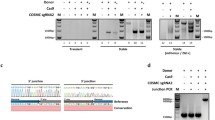Abstract
Long interspersed elements (LINEs, L1s) are non-long terminal repeat (LTR) retrotransposons found in mammalian genomes and account up to 20% of genomic DNA. It has been shown that active L1 elements can cause mutation resulting in disease, genetic variation and polymorphisms and their inactive copies seem to be involved in recombination and rearrangement. L1–encoded products have been detected in a number of tissues including mammalian germ cell tumours, breast carcinomas and a large variety of transformed mouse and human cell lines.
Chinese Hamster Ovary (CHO) cells are widely used in the manufacture of recombinant proteins for biopharmaceuticals. Here, we investigated the transcriptional activity of hamster L1 elements in CHO-K1 cells. These cells were analysed for the presence of L1 RNA transcripts. The sequence, which is homologous to mammalian L1 elements, was cloned from hamster genomic DNA and used to design primers for RT-PCR. L1 transcripts were detected in CHO-K1 RNA.




Similar content being viewed by others
References
Anderson KP, Low MA, Lie YS, Keller GA, Dinowitz M (1991) Endogenous origin of defective retroviruslike particles from a recombinant Chinese hamster ovary cell line. Virology 181:305–311
Boissinot S, Chevret P, Furano AV (2000) L1 (LINE-1) retrotransposon evolution and amplification in recent human history. Mol Biol Evol 17:915–928
Dinowitz M, Lie YS, Low MA, Lazar R, Fautz C, Potts B, Sernatinger J, Anderson K (1992) Recent studies on retrovirus-like particles in Chinese hamster ovary cells. Dev Biol Stand 76:201–207
Emanoil-Ravier R, Hojman F, Servenay M, Lesser J, Bernardi A, Peries J (1991) Biological and molecular studies of endogenous retrovirus-like genes in Chinese hamster cell lines. Dev Biol Stand 75:113–122
Malik HS, Burke WD, Eickbush TH (1999) The age and evolution of non-LTR retrotransposable elements. Mol Biol Evol 16:793–805
Moran JV, Holmes SE, Naas TP, DeBerardinis RJ, Boeke JD, Kazazian HH Jr (1996) High frequency retrotransposition in cultured mammalian cells. Cell 87:917–927
Ostertag EM, Kazazian HH Jr (2001) Biology of mammalian L1 retrotransposons. Annu Rev Genet 35:501–538
Piskareva O, Schmatchenko V (2006) DNA polymerization by the reverse transcriptase of the human L1 retrotransposon on its own template in vitro. FEBS Lett 580:661–668
Sambrook J, Fritsch EF, Maniatis T (1989) Molecular cloning: a laboratory manual, 2nd edn. Cold Spring Harbor Laboratory Press, Cold Spring Harbor, NY, USA
de Wita C, Fautzb C, Xua Y (2000) Real-time quantitative PCR for retrovirus-like particle quantification in CHO cell culture. Biologicals 28:137–148
Xiong Y, Eickbush TH (1990) Origin and evolution of retroelements based on their reverse transcriptase sequences. EMBO J 9:3351–3362
Acknowledgement
This work was supported by Enterprise Ireland (Grant No.TD/05/102)
Author information
Authors and Affiliations
Corresponding author
Additional information
An erratum to this article is available at http://dx.doi.org/10.1007/s10616-007-9068-1.
Rights and permissions
About this article
Cite this article
Piskareva, O., Clynes, M. & Barron, N. Detection and cloning of LINE-1 elements in CHO cells. Cytotechnology 53, 75–80 (2007). https://doi.org/10.1007/s10616-007-9051-x
Received:
Accepted:
Published:
Issue Date:
DOI: https://doi.org/10.1007/s10616-007-9051-x




